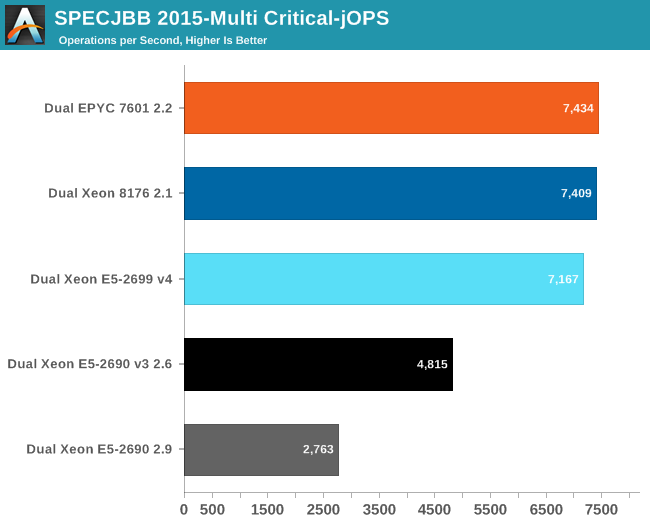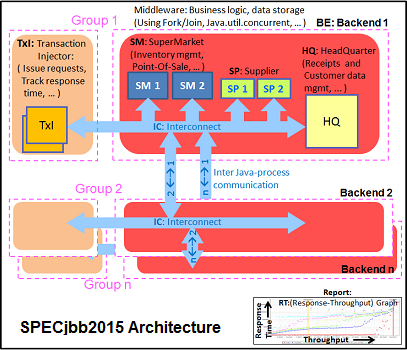Sizing Up Servers: Intel's Skylake-SP Xeon versus AMD's EPYC 7000 - The Server CPU Battle of the Decade?
by Johan De Gelas & Ian Cutress on July 11, 2017 12:15 PM EST- Posted in
- CPUs
- AMD
- Intel
- Xeon
- Enterprise
- Skylake
- Zen
- Naples
- Skylake-SP
- EPYC
Java Performance
The SPECjbb 2015 benchmark has "a usage model based on a world-wide supermarket company with an IT infrastructure that handles a mix of point-of-sale requests, online purchases, and data-mining operations." It uses the latest Java 7 features and makes use of XML, compressed communication, and messaging with security.
We tested SPECjbb with four groups of transaction injectors and backends. The reason why we use the "Multi JVM" test is that it is more realistic: multiple VMs on a server is a very common practice.
The Java version was OpenJDK 1.8.0_131. We applied relatively basic tuning to mimic real-world use, while aiming to fit everything inside a server with 128 GB of RAM:
The graph below shows the maximum throughput numbers for our MultiJVM SPECJbb test.

Even though our testing is not the ideal case for AMD (you would probably choose 8 or even 16 back-ends), the EPYC edges out the Xeon 8176. Using 8 JVMs increases the gap from 1% to 4-5%.
The Critical-jOPS metric is a throughput metric under response time constraint.

With this number of threads active, you can get much higher Critical-jOps by significantly increasing the RAM per JVM. However, we did not want that as this would mean we can not compare with systems that can only accommodate 128 GB of RAM.











219 Comments
View All Comments
ddriver - Tuesday, July 11, 2017 - link
Gotta love the "you don't care about the xeon prices" part thou. Now that intel don't have a performance advantage, and their product value at the high end is half that of amd, AT plays the "intel is the better brand" card. So expected...OZRN - Wednesday, July 12, 2017 - link
You need some perspective. Database licensing for Oracle happens per core, where Intel's performance is frequently better in a straight line and since they achieve it on lower core count it's actually better value for the use case. Higher per-CPU cost is not so much of a concern when you pay twice as much for a processor license to cover those cores.I'm an AMD fan and I made this account just for you, sweetheart, but don't blind yourself to the truth just because Intel has a history of shady business. In most regards this is a balanced review, and where it isn't, they tell you why it might not be. Chill out.
ddriver - Thursday, July 13, 2017 - link
You are such a clown. Nobody, I repeat, NOBODY on this planet uses 64 core 128 thread 512 gigabytes of ram servers to run a few MB worth of database. You telling me to get pespective thus can mean only two things, that you are a buthurt intel fanboy troll or that you are in serious need of head examination. Or maybe even both. At any rate, that perfectly explains your ridiculously low standards for "balanced review".Notmyusualid - Friday, July 14, 2017 - link
It seems no matter what opinion someone presents that might exhibit Intel in a better light - you are going to hate it anyway.What a life you must lead.
OZRN - Friday, July 14, 2017 - link
No, they don't. They use them to host gigabytes to terabytes worth of mission critical databases, with specified amounts of cores dedicated to seperate environments of hard partitioned data manipulation. I've done some quick math for you and in an average setup of Enterprise Edition of Oracle DB, with only the usually reported options and extras, this type of database would cost over $3.7m to run on *64 cores alone*. At this point, where is your hardware sunk costs argument?Also, I don't think anyone here is impressed by your ability to immediately personally insult people making valid points. Good luck finding your head that deep in your colon.
CajunArson - Tuesday, July 11, 2017 - link
"All of our testing was conducted on Ubuntu Server "Xenial" 16.04.2 LTS (Linux kernel 4.4.0 64 bit). The compiler that ships with this distribution is GCC 5.4.0."I'd recommend using a more updated distro and especially a more up to date compiler (GCC 5.4 is only a bug-fix release of a compiler from *2015*) if you want to see what these parts are truly capable of.
Phoronix does heavy-duty Linux reviews and got some major performance boosts on the i9 7900X simply by using up to date distros: http://www.phoronix.com/scan.php?page=article&...
Considering that Purley is just an upscaled version of the i9 7900X, I wouldn't be surprised to see different results.
CajunArson - Tuesday, July 11, 2017 - link
As a followup to my earlier comment, that Phoronix story, for example, shows a speedup factor of almost 5X on the C-ray benchmark simply by using a modern distro with some tuning for the more modern Skylake architecture.I'm not saying Purley would have a 5X speedup on C-ray per-say, but I'd be shocked if it didn't get a good boost using modern software that's actually designed for the Skylake architecture.
CoachAub - Wednesday, July 12, 2017 - link
Keywords: "actually designed for the Skylake architecture". Will there be optimizations for AMD Epyc chips?mkozakewich - Friday, July 14, 2017 - link
If it's a reasonable optimization, it makes sense to include it in the benchmark. If I were building these systems, I'd want to see benchmarks that resembled as closely as possible my company's workflow. (Which may be for older software or newer software; neither are inherently more relevant, though benchmarks on newer software will usually be relevant further into the future.)CajunArson - Tuesday, July 11, 2017 - link
And another followup: The time kernel compilation on the i9 7900X got almost a factor of 2 speedup over the Ubuntu 16.04 using more modern distros.